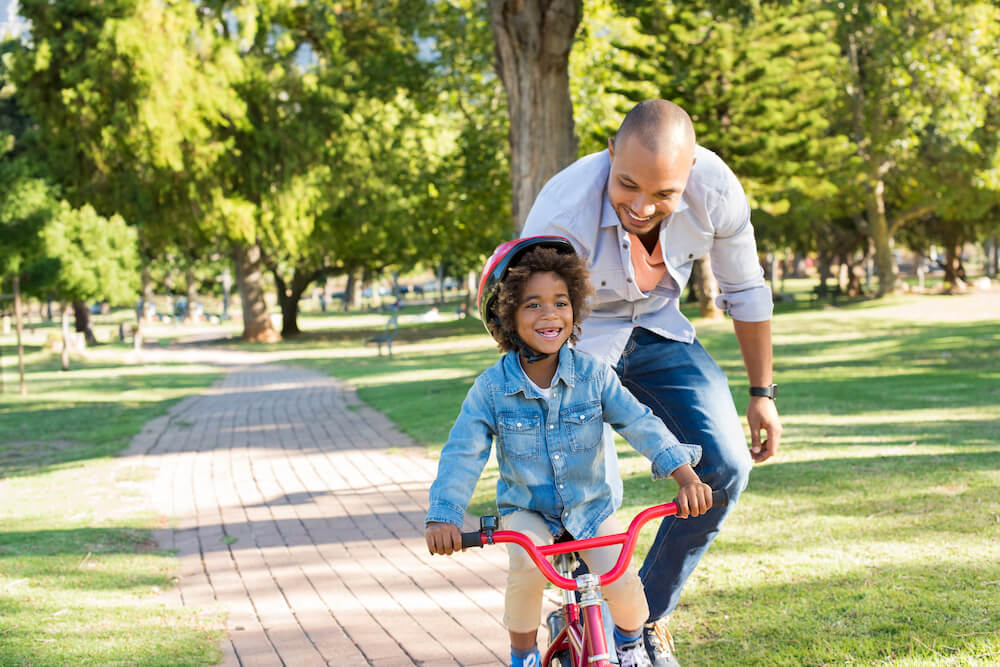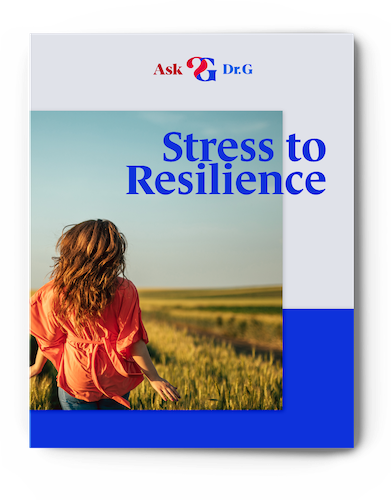Did your child get a bike for the holiday? Learning to ride a bike is one of the best ways to teach your child resilience. Not because they’ll master it quickly, but because it takes practice. And because it’s hard for most kids! They will get frustrated and they will fall, but the lesson is in how they handle those falls and how they pick themselves up, learn from where they went wrong and carry on. It’s an amazing life lesson, learned at an early age.
Safety First
Before your child takes their first ride, you should be sure that they are protected. To get them excited about riding a bike and being safe you may want to get your kids involved in picking out their own safety equipment. Let them choose a helmet they like and a color of pads. This way, they will want to wear them. At first, you should put them in long sleeves and long pants under their pads. That way when they fall, you can reduce the chance of scrapes. Be sure that shoelaces are tied and aren’t dragging around the pedals.
For the bike, make sure that the tires are inflated properly and your child can put both feet comfortably on the ground. Once they are all suited up and their bike is ready, the next step is to find a safe place to ride. Ideally it would be a large open space where they won’t have to worry about obstacles or looking out for cars.
Ready to Ride?
Start Standing has outlined three methods to teach a child to ride a bike. For complete step-by-step instructions, you can visit their site {HERE}.
Method One: No Pedals
In this method, you remove the pedals to the child’s bike and allow them to coast around. This helps them get a center of balance and lets them practice turning. When they are comfortable and mastered their balance on the bike, they can move ahead to learning braking and riding with the pedals back on.
Method Two: Towel Method
This method can help them learn to ride a bike fast, but it requires the parent to run with the child. By wrapping a towel around the body as a harness, it allows you to hold the child up as they learn to balance, pedal, turn and brake.
Method Three: Grass Hill Method
Although this method SOUNDS scary, it is not. If you have access to a small grass hill, you can try this method. It lets children build momentum with the slope safely, as the grass will naturally slow them down and will make a softer landing space if they fall.
No matter what the method, you may encounter some other challenges. This process can be scary for kids and their natural reaction may be to not want to try. It’s up to us to get to the bottom of that fear and help them navigate through it.
Are They Afraid?
Here are some questions you can answer to determine how to deal with your child’s fear of riding a bike.
- What’s the real issue? Is your child afraid of…
- Getting hurt? Don’t ignore this fear. Your child could get hurt, and will only be frustrated if you brush that concern aside. Talk about what bike riders do to protect themselves: helmets, knee pads, etc, and make sure he has a good fitting helmet! Offer practice on a baseball field or grassy area.
- Failing? Of course he will fail the first times he tries. Make that expectation clear, and that your pride in him is based on his efforts, not his accomplishment. Talk about all the ridiculous hobbies people have that no one is good at the first time they try, like ice-skating. Or remind him of how often he fell down learning to walk!
- Embarrassment? Does he want some practice away from siblings or neighbors? Does he feel like he’s already “too old” for this experience? Remind him that he shouldn’t let other people’s expectations take this fun away from him!
2. What does he need?
- Time? He may need you to stop stressing this for a while, just to leave it alone. Some kids (believe, me I have four like this!) just need to come to an idea on their own, or at least believe that they did!
- Togetherness? Most eight year olds still want time with a parent more than anything else. You can use that to encourage his bike riding bravery. Plan an afternoon where you pick 20 minutes of bike practice together and then he gets to pick the next hour’s activity. You can talk about a bike excursion together when he’s riding a two-wheeler.
- Motivation? Ask him what would be a great reason to learn to ride. Then ask him what you can do to help him get motivated. Or talk to him about swimming, and how he felt before and after he learned. He may surprise you with his insight.
3. What doesn’t he need?
- Shame. Telling our kids, “You’re too old to be afraid of this!” or “A big kid like you should already…” or comparing them to others will only leave them with a negative self-image and likely take away any feeling of accomplishment if they do master the task.
- Guilt. Don’t pressure (or let your other kids pressure) him to conquer this fear just so the family can bike together. Let him know you love him the same whether he does this or not, and he’ll be more likely to try.
- Threats. While positive motivation can encourage him, threatening him with punishment if he doesn’t try will leave him unlikely to ever enjoy biking even if he does learn how.
Take this opportunity to teach your child about resilience and yourself a lesson on patience. Remember that he is likely to try most of these things, but maybe not on our timetable, and be as patient as you can!
What were your tips on helping your child to ride a bike? Join the conversation on Facebook or Twitter!





2 thoughts on “How to Teach Your Child to Ride a Bike”
Thank you very much for this post. I have been teaching my kid how to ride a bike f0or a few days., he is doing a very good job. He is only five and has enough courage to ride the bike without the balance wheels. This post has been a huge help. Thanks for sharing this post.
Grass Hill Method is actually scary – I remember how my dad taught me to ride a bike like this, such a nightmare!
Comments are closed.